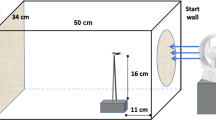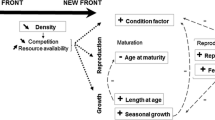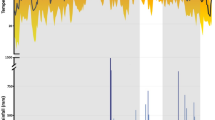Abstract
Invasive species are distinguished by their rate of spread and this is thought to be associated with the ability to produce many offspring. However, it is possible that many studies do not succeed in highlighting a positive correlation between invasiveness and reproductive rate because they lack an allometric perspective. Information on the ladybird beetles introduced into North America and data on life-history traits of 30 species of ladybird beetles were used to search for a relationship between ability to invade and traits related to reproduction and dispersal. We analyzed the mechanisms responsible for the rate of spread of invasive species of the aphidophagous species of ladybird introduced into North America that became established and spread. The two largest species extended their range an order of magnitude faster than the other species. The potential reproductive rate and the speed of movement are both positively correlated with body mass, which appears to be a good predictor of the ability to spread and colonize new territory. Further studies of invasive species should therefore include an allometric perspective in order to allow comparisons between species and an assessment of the influence of reproduction and dispersal potential on the rate with which they spread when exploiting highly suitable habitats.



Similar content being viewed by others
References
Alyokhin A, Sewell G (2004) Changes in a lady beetle community following the establishment of three alien species. Biol Invasions 6:463–471
Angalet G, Tropp JM, Eggert AN (1979) Coccinella septempunctata in the United States: recolonizations and notes on its ecology. Environ Entomol 8:896–901
Beatty S, Morgan D, Gill H (2005) Role of life history strategy in the colonisation of Western Australian aquatic systems by the introduced crayfish Cherax destructor Clark, 1936. Hydrobiologia 549:219–237
Bickhan R, Full RJ (1993) Similarity in multilegged locomotion: bouncing like a monopode. J Comp Physiol A 173:509–517
Boivin T, Rouault G, Chalon A, Candau JN (2008) Differences in life history strategies between an invasive and a competing resident seed predator. Biol Invasions 10:1013–1025
Bradshaw CJA, Giam XL, Tan HTW, Brook BW, Sodhi NS (2008) Threat or invasive status in legumes is related to opposite extremes of the same ecological and life-history attributes. J Ecol 96:869–883
Brown PMJ, Roy HE, Rothery P, Roy DB, Ware RL, Majerus MEN (2008) Harmonia axyridis in Great Britain: analysis of spread and distribution of a non-native coccinellid. In: Roy HE, Wajnberg E (eds) From biological control to invasion: the ladybird Harmonia axyridis as a model species. Springer, Berlin, pp 55–67
Burton OJ, Phillips BL, Travis JM (2010) Trade-offs and the evolution of life-histories during range expansion. Ecol Lett 13:1210–1220
Chapin JP, Brou VA (1991) Harmonia axyridis (Pallas), the third species of the genus to be found in the United States. Proc Entomol Soc Wash 93:630–635
Dailey PJ, Graves RC, Kingsolver JM (1978) Survey of Coleoptera collected on the common milkweed, Asclepias syriaca, at one site in Ohio. Coleopt Bull 32:223–229
Davis MA (2009) Invasion biology. Oxford University Press, Oxford
Daws MI, Hall J, Flynn S, Pritchard HW (2007) Do invasive species have bigger seeds? Evidence from intra- and inter-specific comparisons. S Afr J Bot 73:138–143
Day WH, Tatman KM (2006) Changes in the abundance of native and adventive Coccinellidae (Coleoptera) in alfalfa fields, in northern New Jersey (1993–2004) and Delaware (1999–2004), USA. Entomol News 117:491–502
Day WH, Prokrym DR, Ellis DR, Chianese RJ (1994) The known distribution of the predator Propylea quatuordecimpunctata (Coleoptera: Coccinellidae) in the United States, and thoughts on the origin of this species and five other exotic lady beetle in eastern North America. Entomol News 105:244–256
Devin S, Beisel JN (2007) Biological and ecological characteristics of invasive species: a gammarid study. Biol Invasions 9:13–24
Diaz-Uriarte R, Garland T Jr (1996) Testing hypotheses of correlated evolution using phylogenetically independent contrasts: sensitivity to deviations from Brownian motion. Syst Biol 45:27–47
Diaz-Uriarte R, Garland T Jr (1998) Effects of branch length errors on the performance of phylogenetically independent contrasts. Syst Biol 47:654–672
Dixon AFG (2000) Insect predator-prey dynamics. Ladybird beetles and biological control. Cambridge University Press, Cambridge
Ellis DR, Prokrym DR, Adams RG (1999) Exotic lady beetle survey in northeastern United States: Hippodamia variegata and Propylea quatuordecimpunctata (Coleoptera: Coccinellidae). Entomol News 110:73–84
Evans EW (2000) Morphology of invasion: body size patterns associated with establishment of Coccinella septempunctata in western North America. Eur J Entomol 97:469–474
Evans EW (2004) Habitat displacement of North American ladybirds by an introduced species. Ecology 85:637–647
Full RF, Tu MS (1991) Mechanics for a rapid running insect: two-, four- and six-legged locomotion. J Exp Biol 156:215–231
Gido KB, Franssen NR (2007) Invasion of stream fishes into low trophic positions. Ecol Freshw Fish 16:457–464
Gordon RD (1985) The Coccinellidae (Coleoptera) of America north of Mexico. J NY Entomol Soc 93:1–912
Grabowski M, Bacela K, Konopacka A (2007) How to be an invasive gammarid (Amphipoda: Gammaroidea)—comparison of life history traits. Hydrobiologia 590:75–84
Hayes KR, Barry SC (2008) Are there any consistent predictors of invasion success? Biol Invasions 10:483–506
Hodek I (1973) Biology of Coccinellidae. Dr W Junk NV, The Hague
Hodek I, Michaud JP (2008) Why is Coccinella septempunctata so successful? (A point of view). Eur J Entomol 105:1–12
Honek A, Dixon AFG, Martinkova Z (2008) Body size, reproductive allocation, and maximum reproductive rate of two species of aphidophagous Coccinellidae exploiting the same resource. Entomol Exp Appl 127:1–9
Horn DJ (1991) Potential impact of Coccinella septempunctata on endangered Lycaenidae (Lepidoptera) in Northwestern Ohio, USA. In: Polgar L, Chambers RJ, Dixon AFG, Hodek I (eds) Behaviour and impact of Aphidophaga. SPB Academic Publishing, The Hague, pp 159–162
Kajita Y, Evans EW (2010) Relationships of body size, fecundity, and invasion success among predatory lady beetles (Coleoptera: Coccinellidae) inhabiting alfalfa fields. Ann Entomol Soc Am 103:750–756
Kidd KA, Nalepa CA, Day ER, Waldvogel MG (1995) Distribution of Harmonia axyridis (Pallas) (Coleoptera: Coccinellidae) in North Carolina and Virginia. Proc Entomol Soc Wash 97:729–731
Kindlmann P, Dixon AFG (1999) Generation time ratios—determinants of prey abundance in insect predator-prey interactions. Biol Control 16:133–138
Kley A, Maier G (2006) Reproductive characteristics of invasive gammarids in the Rhine–Maine–Danube catchment, South Germany. Limnologia 36:79–90
Koch RL (2003) The multicolored Asian lady beetle, Harmonia axyridis: a review of its biology, uses in biological control, and non-target impacts. J Insect Sci 3:1–16
Legendre P, Legendre L (1998) Numerical ecology 2nd edn. Number 20 in developments in environmental modelling. Elsevier, Amsterdam
Lockwood JL, Hoopes MF, Marchetti MP (2007) Invasion ecology. Blackwell Publishing, Oxford
Maddison WP, Maddison DR (2006) Mesquite: a modular system for evolutionary analysis. Version 1.1. http://mesquiteproject.org
Magro A, Lecompte E, Magné F, Hemptinne J-L, Crouau-Roy B (2010) Phylogeny of ladybirds (Coleoptera: Coccinellidae): are the subfamilies monophyletic? Mol Phylogenet Evol 54:833–848
Marco DE, Paez SA (2000) Invasion of Gleditsia triacanthos in Lithraea ternifolia Montane forests of central Argentina. Environ Manage 26:409–419
Martel C, Guarini JM, Blanchard G, Sauriau PG, Trichet C, Robert S, Garcia-Meunier P (2004) Invasion by the marine gastropod Ocinebrellus inornatus in France. III. Comparison of biological traits with the resident species Ocenebra erinacea. Mar Biol 146:93–102
Marvier M, Kareiva P, Neubert MG (2004) Habitat destruction, fragmentation, and disturbance promote invasion by habitat generalists in a species metapopulation. Risk Anal 24:869–878
McIntyre S, Martin TG, Heard KM, Kinloch J (2005) Plant traits predict impact of invading species: an analysis of herbaceous vegetation in the subtropics. Aust J Bot 53:757–770
Midford PE, Garland T Jr, Maddison WP (2005) PDAP package of mesquite. Version 1.07
Moravcova L, Perglova I, Pysĕk P, Jarosik V, Pergl J (2005) Effects of fruit position on fruit mass and seed germination in the alien species Heracleum mantegazzianum (Apiaceae) and the implications for its invasion. Acta Ecol Int J Ecol 28:1–10
Musser FR, Nyrop JP, Shelton AM (2004) Survey of predators and sampling method comparison in sweet corn. J Econ Entomol 97:136–144
Partridge L, Harvey PH (1988) The ecological context of life history evolution. Science 241:1449–1455
Phillips BL, Brown GP, Shine R (2010) Life-history evolution in range-shifting populations. Ecology 91:1617–1627
Pimentel D, Lach L, Zuniga R, Morrison D (2000) Environmental and economic costs of nonindigenous species in the United States. Bioscience 50:53–65
Piscart C, Devin S, Beisel JN, Moreteau JC (2003) Growth-related life-history traits of an invasive gammarid species: evaluation with a Laird–Gompertz model. Can J Zool/Revue Canadienne de Zoologie 81:2006–2014
Prokrym DR, Pike KS, Nelson DJ (1998) Biological control of Diuraphis noxia (Homoptera: Aphididae): implementation and evaluation of natural enemies. In: Quisenberry SS, Peairs FB (eds) Response model for an introduced pest—the Russian wheat aphid. Thomas Say Publications in Entomology, USA, pp 183–208
Pysĕk P, Richardson DM (2007) Traits associated with invasiveness in alien plants: where do we stand ? In: Nentwig W (ed) Ecological studies, 193, biological invasions, pp 97–125
R Development Core Team (2010) R: A language and environment for statistical computing. R Foundation for statistical Computing, Vienna. ISBN 3-900051-07-0. URL: http://www.R-project.org
Reiss MJ (1989) The allometry of growth and reproduction. Cambridge University Press, Cambridge
Richardson DM, Pysĕk P, Rejmanek M, Barbour MG, Panetta FD, West CJ (2000) Naturalization and invasion of alien plants: concepts and definition. Divers Distrib 6:93–107
Rosecchi E, Thomas F, Crivelli AJ (2001) Can life-history traits predict the fate of introduced species? A case study on two cyprinid fish in southern France. Freshw Biol 46:845–853
Roy K, Jablonsky D, Valentine JW (2001) Climate change, species range limits and body size in marine bivalves. Ecol Lett 4:366–370
Roy K, Jablonsky D, Valentine JW (2002) Body size and invasion success in marine bivalves. Ecol Lett 5:163–167
Roy HE, Brown PMJ, Majerus MEN (2006) Harmonia axyridis: a successful biocontrol agent or an invasive threat? In: Eilenberg J, Hokkanen H (eds) An ecological and societal approach to biological control. Kluwer Academic Publishers, Dordrecht, pp 295–309
Schaefer PW, Dysart RJ (1988) Palearctic aphidophagous coccinellids in North America. In: Niemczyk E, Dixon AFG (eds) Ecology and effectiveness of aphidophaga. SPB Academic Publishing, The Hague, pp 99–103
Schaefer PW, Dysart RJ, Specht HB (1987) North American distribution of Coccinella septempunctata (Coleoptera: Coccinellidae) and its mass appearance in coastal Delaware. Environ Entomol 16:368–373
Schmidt-Nielsen K (1984) Scaling. Why is animal size so important?. Cambridge University Press, Cambridge
Shea K, Chesson P (2002) Community ecology as a framework for biological invasion. Trends Ecol Evol 17:170–176
Shine R, Brown GP, Phillips BL (2011) An evolutionary process that assembles phenotypes through space rather than through time. Proc Natl Acad Sci 108:5708–5711
Soares AO, Borges I, Borges PAV, Labrie G, Lucas E (2008) Harmonia axyridis: what will stop the invader ? In: Roy HE, Wajnberg E (eds) From biological control to invasion: the ladybird Harmonia axyridis as a model species. Springer, Berlin, pp 127–145
Statzner B, Bonada N, Doledec S (2008) Biological attributes discriminating invasive from native European stream macroinvertebrates. Biol Invasions 10:517–530
Stewart LA, Dixon AFG, Ruzicka Z, Iperti G (1991) Clutch and egg size in ladybird beetles. Entomophaga 36:329–333
Tedders WL, Schaefer PW (1994) Release and establishment of Harmonia axyridis (Pallas) (Coleoptera: Coccinellidae) in the southeastern United States. Entomol News 105:228–243
Tilman D (1990) Mechanisms of plant competition for nutrients: the elements of a predictive theory of competition. In: Grace JB, Tilman D (eds) Perspectives on plant competition. Academic Press, San Diego, pp 117–141
Vandenberg NJ (1990) First North American record for Harmonia quadripunctata (Pontopiddian) (Coleoptera: Coccinellidae); a lady beetle native to the Palaearctic. Proc Entomol Soc Wash 92:407–410
Vila-Gispert A, Moreno-Amich R (2003) Life-history strategies of native and introduced fish species from a Mediterranean lake. Anim Biol 53:47–57
Wheeler AG Jr, Hoebeke ER (1981) A revised distribution of Coccinella undecimpunctata L. in eastern and western North America (Coleoptera: Coccinellidae). Coleopt Bull 35:213–216
Acknowledgments
This paper was started when E. W. Evans was on a sabbatical leave at ENFA (France) and was further continued during research visits of A. F. G. Dixon. The laboratory studies of J-L. Hemptinne and A. Magro were funded by grant ANR-06-BDIV-008-02 (Etudes des invasions biologiques à partir d’introductions intentionnelles et non intentionnelles d’insectes). The authors thank E. Brockerhoff (Forest Research, Christchurch, New Zealand) and A. O. Soares (Universidade dos Açores, Portugal) for helpful discussions. They also express their gratitude to Emilie Lecompte (Université de Toulouse III, UMR EDB, France) for assistance in handling the phylogenetic data, and Laurent Lelli (Ecole nationale de Formation agronomique, UMR Metafor, Toulouse) for drawing the maps.
Author information
Authors and Affiliations
Corresponding author
Appendix
Appendix
See Table 3.
Rights and permissions
About this article
Cite this article
Hemptinne, JL., Magro, A., Evans, E.W. et al. Body size and the rate of spread of invasive ladybird beetles in North America. Biol Invasions 14, 595–605 (2012). https://doi.org/10.1007/s10530-011-0101-0
Received:
Accepted:
Published:
Issue Date:
DOI: https://doi.org/10.1007/s10530-011-0101-0




